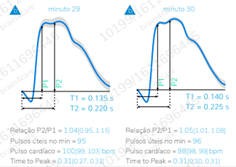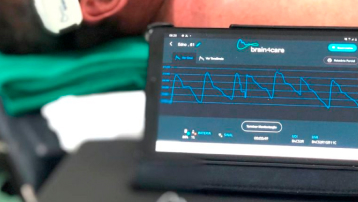Child with ventriculoperitoneal (VP) shunt since birth due to hydrocephalus. Patient showing good development, however the parents complained of slight hypoactivity sporadically.
How did the sensor help?
The brain4care sensor helped in the initial detection of changes in intracranial compliance and in real-time monitoring of the effect of the change in VP shunt regulation, showing the physician the best value to keep it.
Results presented:
Monitoring with the brain4care sensor showed that intracranial compliance was altered, with a P2/P1 ratio greater than 1.0, suggesting P2>P1.

The result collaborated with the decision to change the VP shunt setting, allowing greater cerebrospinal fluid outflow from the skull, a procedure that resulted in the result below, indicating an improvement in intracranial compliance and indicating that the new VP shunt opening value was correct.




